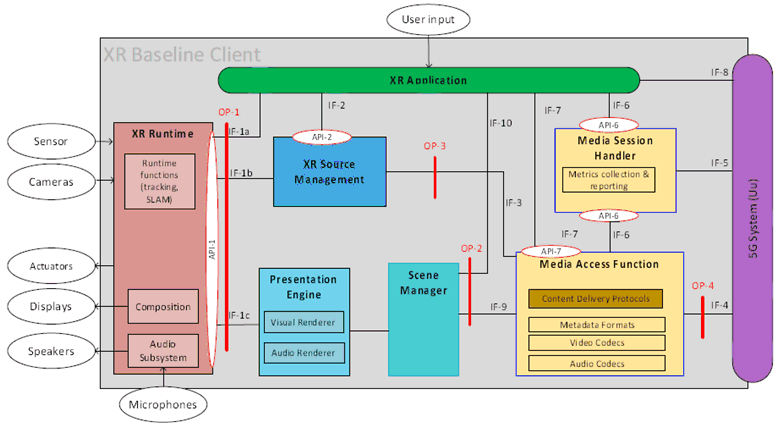Content for TS 26.119 Word version: 18.0.0
11 QoE metrics
11.1 Metrics and Observation Points
11.1.1 Overview
11.1.2 Observation Point 1: XR Runtime information
11.1.3 Observation Point 2
11.1.4 Observation Point 3
11.1.5 Observation Point 4
11.2 Metrics Definitions
11.2.1 Latency metrics
...
...
11 QoE metrics p. 30
11.1 Metrics and Observation Points p. 30
11.1.1 Overview p. 30
The Observation Points (OPs) are defined to support the definition of the corresponding metrics. This specification defines four observation points as shown in Figure 11.1.1-1. The metrics collection function, as part of the Media Session Handler, is responsible of collecting specific information observed at each OP in order to generate the metrics. This function has also access to the 5G System such that the metrics can be reported to an external entity.

11.1.2 Observation Point 1: XR Runtime information p. 31
Observation point 1 (OP-1) is derived from the XR Runtime API. The OP-1 observes information exchanged between the XR Runtime on one side and the XR Source Management, the Presentation Engine and the application on the other side, i.e. on IF-1.
On observation point 1, the following observed information is defined:
- XR runtime clock (XR runtime clock)
- Actual presentation/display time
- user input actions and the time when the action is made
- Rendering loop timing information: to observe the start of the scene update by the scene manager and the start of the rendering process.
11.1.3 Observation Point 2 p. 31
Observation point 2 (OP-2) observes information at the input of the Scene Manager, i.e. on IF-9 for data received from the Media Access Function and the IF-10 for information exchanged between the Scene Manager and the application.
11.1.4 Observation Point 3 p. 31
Observation point 3 (OP-3) is derived from the API which exchanges information between the XR Source Management and the Media Access Functions. It corresponds to the IF-3 interface.
11.1.5 Observation Point 4 p. 31
Observation point 4 (OP-4) observes information between the Media Access Function and the 5G System, i.e. on IF-4 interface.
11.2 Metrics Definitions p. 32
11.2.1 Latency metrics p. 32
To enable good XR experiences, it is relevant to monitor latencies such as the pose-to-render-to-photon.
Beyond the sense of presence and immersiveness, the age of the content and user interaction delay are of the uttermost importance for immersive and non-immersive interactive experiences, i.e. experiences for which the user interaction with the scene impacts the content of scene (such as online gaming).
Table 11.2.1-1 provides time information that may be gathered to compute the latency metrics. The observation points to collect the time information are indicated per device type.
| Time information | Definition | Observation Point |
|---|---|---|
| estimatedAtTime
(ref. T1) | The time when the viewer pose prediction is made. It corresponds to the time when the predicted viewer pose is collected using the XR runtime API-1 by the application or the XR Source Manager. This time is expressed in XR system time clock. | OP-1 |
| lastChangeTime | The time when the user action is made. It corresponds to the lastChangeTime field defined in the action format in Table 5.1.3-1. This time is expressed in XR system time clock. | OP-1 |
| sceneUpdateTime
(ref. T6) | The time when the Scene Manager starts to update the 3D scene graph according to the viewer pose and the user actions. This time is expressed in wall clock time | OP-1 |
| startToRenderAtTime
(ref. T3) | The time when the renderer starts to render the scene according to the viewer pose. This time is expressed in wall clock time | OP-1 |
| actualDisplayTime
(ref. T2.actual) | The actual display time of the rendered frame in the swapchain. The estimation of the actual display time is available through the XR runtime. This time is expressed in XR system time clock. | OP-1 |
The latency metrics are specified in Table 11.2.1-2. The formula to compute the latencies are defined using the collected time information.
| Latency metric | Description |
|---|---|
| poseToRenderToPhoton | The time duration, in units of milliseconds, between the time to query the pose information from the XR runtime to the renderer (the renderer uses this pose to generate the rendered frame) and the display time of the rendered frame. It can be computed as follows: actualDisplayTime - estimatedAtTime |
| renderToPhoton | The time duration, in units of milliseconds, between the start of the rendering by the Presentation Engine and the display time of the rendered frame. It can be computed as follows: actualDisplayTime - startToRenderAtTime |
| roundtripInteractionDelay | The time duration, in units of milliseconds, between the time a user action is initiated and the time the action is presented to the user. It can be computed as follows: actualDisplayTime - lastChangeTime |
| userInteractionDelay | The time duration, in units of milliseconds, between the time a user action is initiated and the time the action is taken into account by the content creation engine in the scene manager. It can be computed as follows: sceneUpdateTime - lastChangeTime |
| ageOfContent | The time duration, in units of milliseconds, between the time the content is created in the scene by the Scene Manager and the time it is presented to the user. It can be computed as follows: actualDisplayTime - sceneUpdateTime |
| sceneUpdateDelay | The time duration, in units of milliseconds, spent by the Scene Manager to update the scene graph. It can be computed as follows: startToRenderAtTime - sceneUpdateTime |